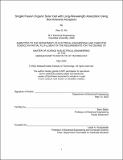Singlet Fission Organic Solar Cell with Long-Wavelength Absorption Using Non-fullerene Acceptors
Author(s)
Wu, Alice Q.
DownloadThesis PDF (888.9Kb)
Advisor
Baldo, Marc
Terms of use
Metadata
Show full item recordAbstract
Organic solar cells made with singlet exciton fission materials are able to convert a single photon into two charges. Paired with a long-wavelength absorbing acceptor material, singlet fission materials enable solar cells that exhibit the quantum efficiency benefits of a multi-junction solar cell, with the simplicity of a single-junction structure. We investigated bilayer solar cells using tetracene, a singlet fission material, and Y6, a long-wavelength non-fullerene acceptor material. We characterized their current-voltage characteristics, internal and external quantum efficiency, and change in photocurrent under a magnetic field. We demonstrated successful triplet exciton dissociation at the donor-acceptor interface and a positive contribution to the photocurrent from singlet fission. In addition, we investigated coupling a thin layer of tetracene to a PM6:Y6 bulk heterojunction solar cell, which is well-known OPV structure. We found that the addition of tetracene boosts external quantum efficiency at its peak absorption wavelengths and the overall power conversion efficiency. Further improvements to the device structure and materials should yield even more promising results.
Date issued
2022-05Department
Massachusetts Institute of Technology. Department of Electrical Engineering and Computer SciencePublisher
Massachusetts Institute of Technology